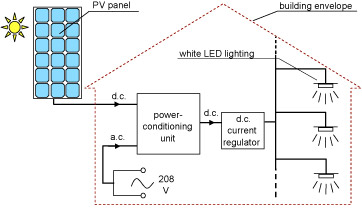|

Solar-Powered LED Lighting for Buildings

Schematic of a photovoltaic system for lighting buildings.
|
Solar power, also known as photovoltaic or PV power, has existed for many years. Despite their potential to produce clean energy, PV systems are not common because of their high initial cost and low power production. Also, PV systems produce d.c. power, which cannot be used efficiently or reliably to operate many traditional light sources without conversion and battery storage, which also introduce efficiency losses. LEDs, however, can work effectively off d.c. power. Recent advancements also now offer more potential for LEDs to provide general illumination.
In this study, the LRC evaluated the system efficiencies of different types of PV systems and the potential for LEDs to be used in PV-powered general lighting applications.
EXPERIMENT
LRC researchers calculated the efficiencies of various lighting systems using three types of PV-powered systems. Calculations were based on known efficiencies for the different light sources and system components, and experiments run on a power conditioning system using both PV and grid power.
The table below summarizes the system efficacy (lumens/solar watt) for different system configurations of PV-powered lighting systems in general lighting applications. The unit "solar watt" refers to the solar radiation power falling onto the PV panels.
| system configuration |
d.c. light source |
a.c. light source |
| White LED |
Halogen |
CFL |
Linear Fluorescent |
stand-alone systems
(PV + battery)
|
2.2
lumens/solar watt |
1.9
lumens/solar watt |
4.4
lumens/solar watt |
6.5
lumens/solar watt |
utility-connected systems
(PV + grid, no battery) |
2.4
lumens/solar watt |
2.1
lumens/solar watt |
4.9 lumens/solar watt |
7.3
lumens/solar watt |
hybrid systems
(PV + grid + battery) |
Depending on the proportion of usage between grid and battery
|
CONCLUSIONS
The system efficacy of PV-powered LED lighting systems using white LEDs is higher than those using halogen lamps, but is still not as high as those using CFLs and linear fluorescent lamps. The main reason for this difference is that the luminous efficacy of white LED lamps still does not match that of other light sources. Therefore, the system efficacy of the white LED still is not competitive enough to be used in PV-powered lighting systems for buildings. But with the rapid development of LED technology, LED light sources have the potential to become the preferred light source for PV-powered lighting systems for buildings in the near future.
TECHNICAL PAPER
Zhou, Y., and N. Narendran. 2005. Photovoltaic-powered light-emitting diode lighting systems. Optical Engineering 44(11): 111311.
Full-text PDF 
SPONSORS
New York State Energy Research and Development Authority
RPI School of Architecture
|


